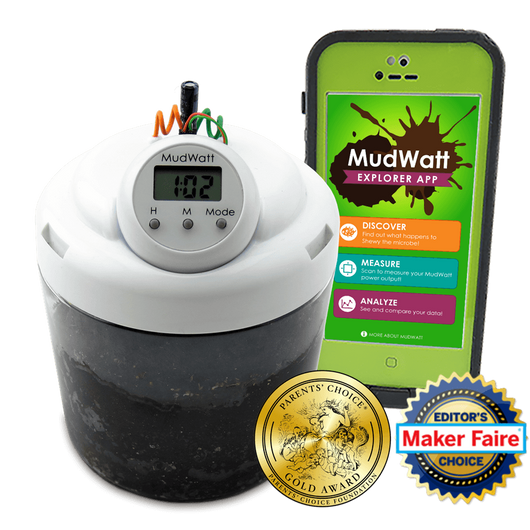
Discover the POWER beneath your feet!
MudWatt engages kids in STEM in a whole new way, using the power of electricity-generating bacteria living in the soil beneath our feet!
(MudWatts are reusable and can last for years!)Kids experiment with different types of soil (and food from the fridge) to maximize their power output. The MudWatt Explorer App lets kids measure their power, track their MudWatt’s bacteria growth, and unlock an awesome educational comic book!
Microbiology, Energy, Chemistry, Physics, and Environmental Engineering, all in one experience!
Activity Duration:
- Building your MudWatt: 30-45 Minutes
- Measuring your MudWatt's growth: Once per day for 2 weeks
- Analyzing data: 30 Minutes
- Keeping it blinking: Can last up to decades!
-
1 Complete MudWatt Unit (1 Anode, 1 Cathode, 1 Vessel, 1 BlinkerBoard)
-
1 20-Page Educational/Instruction Booklet
-
1 Pair of Black Nitrile Gloves
-
MudWatt Explorer App (available on iTunes and Google Play)
Science Fair Pack Includes:
-
3 Complete MudWatt Units (3 Anodes, 3 Cathodes, 3 Vessels, 3 BlinkerBoards, 1 Digital Clock)
- 2 Pairs of Alligator Cables and Jumper Wires (for connecting MudWatts together)
-
1 20-Page Educational/Instruction Booklet
-
1 Pair of Black Nitrile Gloves
-
MudWatt Explorer App (available on iTunes and Google Play)
-
10 Complete MudWatt Units (10 Anodes, 10 Cathodes, 10 Vessels, 10 BlinkerBoards, 3 Digital Clocks)
- 10 Pairs of Alligator Cables and Jumper Wires (for connecting MudWatts together)
- 10 20-Page Educational/Instruction Booklets
-
10 Pairs of Black Nitrile Gloves
-
MudWatt Explorer App (available on iTunes and Google Play)
What is the recommended age for MudWatt?
All Ages...really. The MudWatt is adaptable to all ages, from elementary school to college. The more advanced the user, the deeper they dive into the awesome MudWatt science!
How is MudWatt different from a lemon/potato battery?
The MudWatt, in combination with the MudWatt Explorer App, offers a long-term experimental platform for learning about microbiology, decomposition, nutrient cycling, soil chemistry, biochemistry, and electrical engineering. The MudWatt is a renewable power source that turns chemical energy into electrical energy, using micro-organisms to drive the process. The lemon/potato battery, on the other hand, is a simple battery that involves the corrosion of two different metals (typically zinc and copper) to produce electricity and does not provide an ongoing educational experience. That dang potato battery is the bane of MudWatt's existence--talk about dirty energy!
Are MudWatts reusable?
Yes! You can use them again and again. You'll just need to clean them out by rinsing the electrodes and container. You might also want to rinse the electrodes in a little ethanol (i.e. Vodka) or rubbing alcohol to kill the existing microbes and start with a clean slate.
How long can the MudWatt last?
Many years! Once a MudWatt has developed a healthy community of electricity-generating microbes, it will continue to produce power until it runs out of nutrients at the anode, or oxygen at the cathode. This process can take decades! If your MudWatt ever runs out of nutrients, just give it some more.
How does the MudWatt work?
Microbes! They are found in virtually all soils, sediments, and streams on the planet. Among the diverse communities of microbes are particular species with unique metabolic abilities that enable them to expel electrons onto oxidized metal compounds, such as rust. In a sense, these so-called “electrogenic” microbes are able to “breathe” metal compounds much like humans and other organisms breathe oxygen. The MudWatt employs these unique metabolisms by providing electrogenic microbes with a certain configuration of two graphite-based electrodes placed in environments with different amounts of oxygen. For more information, check out our Educational Resources page.
How wet should the cathode be?
Damp, but not submerged. The cathode should rest on top of wet soil, but the cathode should not be submerged in water. It is very important that the cathode be fully exposed to the air, with no water or mud above it. This will ensure that the cathode has enough oxygen to "breathe" and perform properly.
How does the Hacker Board work?
The Hacker board lets you interact with your MudWatt in a fun and exploratory way. The included blinker circuitry gives you a visual indication that your microbes are hard at work. The faster it blinks, the happier your microbes are! Moreover, the Hacker's 8-pin breadboard gives you the freedom to install new devices and "hack" the MudWatt to perform new functions. So get out there, get creative, and explore new mud-power frontiers! Here's how it works: The Hacker Board's microchip will take in the steady, constant power coming from the MudWatt and will up-convert the voltage to 2.4 Volts in short bursts, which will then enable you to power the LED, the Clock, and many commercially available devices. The capacitors are necessary for this up-converting to take place, as well as to smooth out the bursts to power your devices continuously. Note: MudWatt electronics use lead-free solder and all components are ROHs compliant.
Does the MudWatt need special bacteria?
Yes, but you already have them! The MudWatt requires electrogenic (electricity-generating) microbes to function. Luckily, these microbes are already ubiquitous throughout the world's soils, sediments, and effluents. In the MudWatt, your soil acts as your inoculum, so you're all set!
How much power will my MudWatt produce?
Your MudWatt's power output depends on what you feed it and the position of its electrodes. We encourage users think about what microbes would like to eat and to design their own fuels using soil and whatever they find in their refrigerator. With standard topsoils and with an electrode distance around 4 cm, typical power levels are around 50 microWatts. If you experience less than 20 microWatts at max, check out our troubleshooting steps below.
Troubleshooting: MudWatt power is low...
Typically it takes about 3-7 days to ramp up. You will need a voltage of at least 0.35V in order to activate the Hacker Board circuit that makes the LED blink. Here are a few common steps that can help you get your MudWatt operating like a fine-tuned machine:
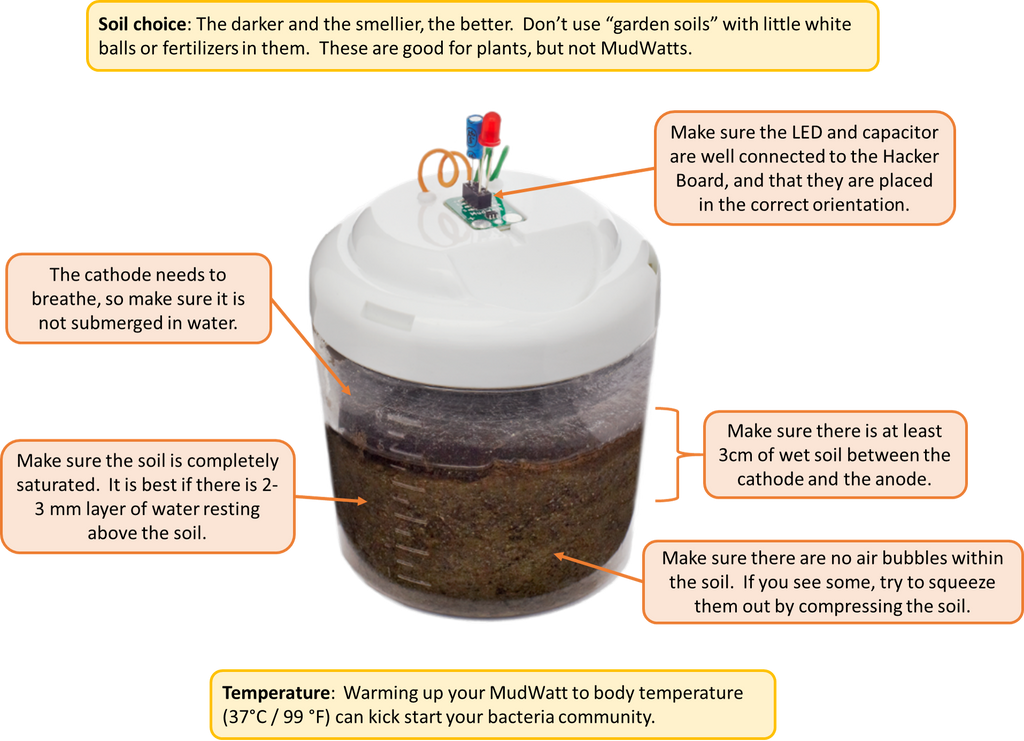
These steps usually get MudWatts going on the right track. If you still experience issues, please drop us a line at info@magicalmicrobes.com!
"When I was first introduced to the MudWatt, I knew immediately that I discovered gold! Whether you are teaching biology, earth science, physics or engineering, the MudWatt is a great tool to help your students see their environment, especially mud, in a whole new way."
- Doron Markus, Science and Engineering Coordinator, San Mateo Office of Education
The resources below are completely free for non-commercial use. Please feel free to download and edit them to best suit your classroom! If you have any questions, please leave us a message at (617) 858-0728 or info@magicalmicrobes.com.
CURRICULA: NGSS Module

MudWatt NGSS Main Module
MudWatt Materials

MudWatt Power and Population Calculator

"The Electric Microbe" Comic Book

MudWatt Educational and Instructional Booklet

¡Guía Para Descubrir la Potencia del Lodo!
Scientific Articles
Clock Assembly Tutorial
MudWatt Explorer App Tutorial










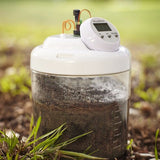
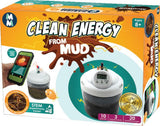
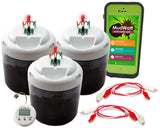
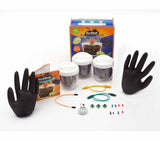
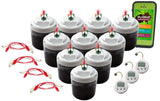
 BackYardNet: A Dirt-Powered Sensor Network
BackYardNet: A Dirt-Powered Sensor Network